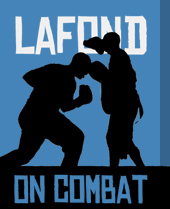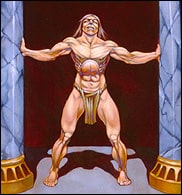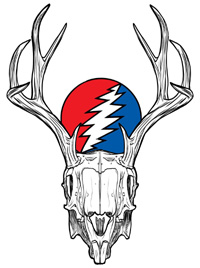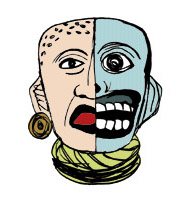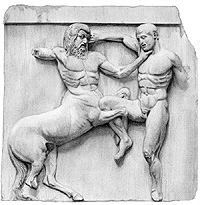Rout is its own brief game.
No command cards are drawn.
If a player has a Rout deck, that is now his hand.
The Phases of Play Are:
-Final Morale
-Break, Retreat or Stand?
-Rest, Pursuit or Slaughter?
-Pursuit
-Victory
…
Final Morale
The current morale of both armies is recorded.
Those totals are retained as victory points.
…
Break, Retreat or Stand?
An army which is broken, has every unit make a morale check.
Failure reduces unit morale by 1.
Static units have a clubs morale, and are reduced on the draw of any other suit.
Spades units that draw a joker are broken. Those that draw a spade, may be reduced if they draw a second spade.
Spade and Hearts units which are at full morale, on Heads, may stand and face the enemy, or may retreat at half movement with their facing towards the enemy.
All demoralized units that are reduced to tails, move at full movement facing away from the enemy along the path that affords the greatest mobility.
All static and broken units that fail their check, being probably 75%, are eliminated from play.
Static and broken units that make their morale check rout the same as demoralized units.
Units must seek the map edge that player operated from.
Broken and routing units that reach the table edge are set aside in a defeated pile to be saved for a future battle in a campaign game and to be counted, as victory points by that player.
Broken units forced off a neutral flanking table edge are eliminated, placed in the slaughter pile of the enemy player.
Units that stand may not attack, but may not be passed within 1 movement token, and hence serve to cover the retreat of other units.
Screening
Screening is an act that may be engaged in by any horse troop at full morale, with a heads token. This unit may move backwards, a half space away from a unit that is advancing upon it, slowing that unit by 1 movement point.
A company of foot may, likewise screen against n advancing unit, but only in a village or wood, or against other foot [not against horse] in a swamp.
Retreating and screening units may exit one of the flanking table edges, if necessary.
Heads units that stand, retreat and screen, exiting the board in good order, rather than routing, are placed in a veteran pile.
…
Rest, Pursuit or Slaughter?
If one of the armies has not broken, each unit makes a morale check, same as the broken army units.
Failure to make this morale check does not eliminate a unit or a token. Static, broken and demoralized units maintain their marked status and remain on the board to be counted.
Noble units marked with a dime on tails as demoralized, that make their morale check, are restored to heads.
Guards units on tails that make a morale check are also restored.
Guards units at full morale may not fail a morale check, but do make one. If the suit drawn is a spade or joker, then a friendly unit within movement range may be promoted to guard and placed on heads. [Even companies, troops and batteries.]
…
Pursuit
Each player should keep three piles off out of play units:
-1. broken and static units that have fled off the map, defeated pile
-2. demoralized and full morale units honorable removed from play, veteran pile
-3. eliminated units, slaughter pile
Now that the status of both armies have been determined and the broken army, perhaps two broken armies, has begun routing, cards may be played, if any, from the player’s hands, one at a time. Units tat are routed off the map edge as broken or static are placed in the defeated pile.
The card played by the defender may only be used to move units towards the map edge. Units may be moved with any suit of card.
A jack permits a routing player to remove any one demoralized or full morale unit of that suit from anywhere on the map at no point cost.
A jack permits the pursuing player, at no cost, to eliminate any one enemy unit of that suit that is within movement range of any of his units, with that unit replacing the eliminated unit and possibly cutting the retreat of another unit or units off.
A queen, may be used by the routing player, free of cost, saving the points to be used retreating or routing units, to win Honors of War for any unit of her same suit. This unit may be removed to the veteran pile.
Conversely, the pursuing player may expend a queen’s 12 points maneuvering and attacking, and then gain the surrender of any unit of her same suit within movement range of a unit of that sit or higher. This unit is then placed in the veteran pile of the pursuing player.
The joker and high joker may act as a jack or a queen.
A king that is played in the pursuit phase by either player, has the following effects:
-Played by the routing player, gains the safe exit of all units of that suit, going to his veteran pile.
-Played by the pursuing player, eliminates all units of that suit and all routing static units and are placed in his slaughter pile.
All units eliminated during play or pursuit are placed in the pursuing player’s slaughter pile.
The pursuit phase ends when all units of the broken force are eliminated or off the map, or:
-In cases where both armies broke, after all cards from the Rout Hands are played, or:
-When the pursuing player declares Honors of War, which gains him 20 Victory points.
…
Victory
Broken Army [the fate of both armies after many battles of the American Civil War] add:
-Final Morale, plus
-Point value of defeated units, plus
-Double point value of units remaining in the field, plus
-Double point value of slaughtered enemy units, plus
-Triple point value of veteran units, plus
-Objectives taken, equals
Total and compare victory points.
-Draw is a battle with final point difference of less than 25.
-Marginal Victory is awarded to a victor with less than twice the points as the vanquished.
-Decisive Victory is awarded for two times more victory points.
-Crushing Victory is awarded for three times more victory points.
…
Campaign Games
To simulate long running conflicts with multiple battles:
For each defeat a general has experienced, he should get an additional card for his draw deck.
For each victory, a general should gain the option of drawing the top discard or the top card of the deck, instead of playing from his draw hand.
Veteran units should gain an extra coin of their unit type, representing enhanced unit cohesion, before the next battle. In the case of companies and troops, this fame should result in increased unit strength by 1.
…
Multiple players to each side will make for a more realistic battle simulation than 1 on 1 play.
In 2 player on 1 player games, the draw deck should be split between the two players, 4 and 3 cards of the allied side.
In 2 on 2, 2 on 3 or 3 on 3 play, each side should elect a leader, with that player receiving 4 cards, plus 3 cards for each subordinate. The players should then repair to separate rooms, with the leader general issuing 3 or 4 cards to each of his subordinates.
For large games using dominoes of different colors might help with visual clarity.
…
Designer’s Note
It is hoped that the game mechanics presented thus far will make for enjoyable play. The remaining chapters are historical notes and simulation ideas that introduce no new game concepts. You have what you need to play out realistic battles from the period of history that shaped our own. If you would like the historical options the entire document will be available.
Thank you.
JL, Portland, Oregon, 3/7/24



